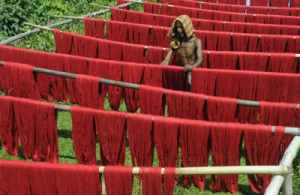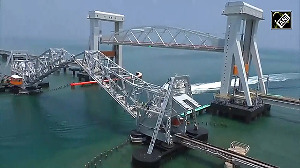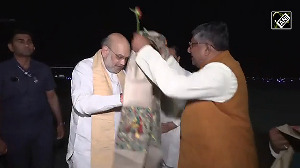The Indian Textiles Industry has an overwhelming presence in the economic life of the country. Under 11th Five Year Plan (FYP) it was projected to accelerate to a growth rate of 16 per cent in value and should reach the value of USD 115 billion (exports USD 55 billion and domestic market USD 60 billion) by 2012. Exports are likely to reach USD 32 billion in 2011-12 and domestic market USD 55 billion. The domestic textile industry comprises of 1608 spinning mills and 200 composite mills, with an installed capacity of 43.27 million spindles (of which 33.25 million spindles are in operation), 523,000 Open End Rotors (of which 384612 are operational) and 52,000 looms (of which only 14500 are under operations) in the organized sector along with another 1219 small scale spinning units with 4.89 million spindles and about 242023 Rotors in the small scale decentralised sector.
The domestic textile industry comprises of 1608 spinning mills and 200 composite mills, with an installed capacity of 43.27 million spindles (of which 33.25 million spindles are in operation), 523,000 Open End Rotors (of which 384612 are operational) and 52,000 looms (of which only 14500 are under operations) in the organized sector along with another 1219 small scale spinning units with 4.89 million spindles and about 242023 Rotors in the small scale decentralised sector.
Globally, cotton prices have spurred up in the cotton 2010/11, thanks to the upsurge in demand from the leading consumers and exports. In India prices of leading variety of cotton Shankar 6A shot up 61 per cent from Rs 104 per Kg in September 10 to Rs 168 per kg in March 11. This sharp increase in the cotton prices has easily passed on by the spinning sector due to lower inventories and pent up demand till March 11.
However since then demand eased both globally and domestically, as the downstream players were unable to pass on the sudden sharp rise in the raw material prices. With the dip in demand cotton prices witnessed free fall from the March 11 levels.
In just two months, cotton prices fell sharply 22 per cent to Rs 117 per Kg in May. Resultantly, spinners have piled up inventory at higher cotton prices and with sudden drop in demand; they have to undertake huge losses on higher value of inventory. With subdued demand cotton prices further eased to Rs 100 per kg in August 11.
In the current new cotton season 2011/12 (Oct Sept), the cotton prices remained lower as the demand sentiments in the domestic market have not picked up. In the beginning of March 11, DGFT has notified ban on cotton exports with immediate effect on 5 March 12.
The cotton exports registrations stood at around 120 lakh bales as on 5 March 12 and thus the exportable surplus registered but not yet shipped was to the tune of 24 lakh bales. As on 4 March 12, cotton arrivals are to the tune of 233.76 lakh bales leading, nearly 50 per cent of arrivals booked for exports. CAB estimated the cotton crop to be flat at 340 lakh bales and domestic consumption to decline by 8 per cent to 250 lakh bales in CY11/12.
After the representations from all the leading cotton producing state governments on the price, the Government has took off ban on cotton exports and notified that "Exports orders already registered with DGFT so far but not yet exported will be expeditiously scrutinized to ensure that their papers are in order and revalidated".
Sharp volatility in the commodity prices has dented the competitiveness of the industry in FY12. While huge cotton price and spike in interest rates dumped the spinning industry in to losses in H1FY12, spike in the raw material prices and levy of 10 per cent excise duty on branded garments have dented the consumer sentiment amidst increasing interest rate cycle for the garment industry. Further, the recent concession of custom duty free import given to Bangladesh and Nepal, apart from Bhutan and Maldives is adding pressure to the garment industry in India.
However, RBI has rejected proposal of Textile Ministry to restructure around Rs 1,00,000 crore either by extension of moratorium period etc. According to the available statistics, total outstanding loans to textile industry by banking industry amounts to Rs 1,54,480 crore at end of January 11.
In this background list of textile related associations namely, Confederation of Indian Textile Industry, Federation of All India Textile Manufacturers' Association (FAITMA), Southern India Mills Association (SIMA) and Indian June Mills Association (IJMA) have appealed Government to consider the following requests ahead of Union Budget 2012-13.
CITI Recommendations:
Withdraw mandatory excise duty of 10 per cent on branded garments and made ups while continuing optional routes for all segments in the textile and clothing sector.
Abolish 5 per cent customs duty and 4 per cent SAD, 10 per cent mandatory excise duty applicable on man-made fibers. Also cut the optional excise duty on manmade fiber products from 10 per cent to 4 per cent there by paving road to "fiber neutral duty structure".
To improve the consolidation and modernization of fabrics sector, extend the facility of optional excise duty to all automated and shuttle less looms instead of current mandated excise duty structure
Withdraw excise duty on all liquid fuels used by the textile and clothing units for Captive power generation
Reduce interest rate on working capital for purchase of cotton to 7 per cent at par with other agricultural products and the margin money for such working capital may be reduced to 10 per cent.
Continue Technology Upgradation Fund Scheme (TUFS) scheme during entire 12th five-year plan. Capital subsidy of 25 per cent of the cost including civil work may be made available to all Effluent Treatment Plants (ETP's) to be established by units in the textiles and clothing industry.
Export credit may be made available for all textile products at 7 per cent interest and levies at the level of state and local bodies amounting to 6 per cent which is currently not being refunded to exporters through any scheme may be refunded through duty drawback scheme or any other scheme.
FAITMA Recommendations:
Excise duty at 4 per cent should be imposed on man-made fibres, POY and filament yarns.
Resolve anomaly on "shawls of synthetic fibres" covered in different headings which also attract differential import rates.
Extend concessional import duty to parts imported for maintenance of Textile Machinery, in line with the full machines or parts required for the manufacture of full machines. Also Excise duty exemption should be restored for all the four types of shuttle less looms. (Current excise duty is 5 per cent).
As the intent of "zero import duty scheme" is different from that of TUFS; allow textile industry to benefits from availing of EPCG Zero Duty Scheme.
Requests for a special meeting before implementation of GST in textile industry.
SIMA Recommendations:
Considering under utilisation of existing spinning capacity, exclude the spinning sector from the purview of TUF Scheme. Also provide 50 per cent Capital subsidy for common/individual marine discharge ETP.
Remove anti-dumping duty on import of man-made fibres.
Permit the manufacturer exporters of yarn to fulfill the export obligation fixed under EPCG scheme by exporting fabric and garment.
Provide 25 per cent capital subsidy for captive power plants of textile industry including windmills.
IJMA Recommendations:
Continue full exemption of all jute products from excise duty.
Reduce cost of production of Jute goods by abolishing Excise Duty on various input items like Bailing, Hooks, Buckles (which are currently attracting excise duty of 10 per cent each respectively) and Jute Batching Oil (14 per cent).
Restart Duty Draw Back scheme which has been abolished from October 11, So as to improve competitiveness of domestic jute industry.
Continue "nil" excise duty on purchase of jute mill machinery. Also allow Duty Free Import of High-Tech Jute Mill Machinery to speed up the process of modernization of jute industry.
Increase the list of countries like Brazil, Egypt, Ghana, and Turkey to the list under Focus Market Scheme and also increase assistance from current 3 per cent to 5 per cent. Jute and its products may be brought under Focus Product Scheme as jute is also an agricultural product.
Allow development of jute industry by providing higher rate of depreciation on the investment in the first year, thereby reducing the burden on the level of investment.
Analyst Expectations:
Almost all the associations have requested for the extension of TUFS scheme for the 12th five year plan (starting FY13-17). TUFS was introduced in 1999 to catalyze investments in all the sub-sectors of textiles and jute industry by way of 5 per cent interest reimbursement. Since its inception, Rs.11196 crore of subsidy has been released till FY11 of which Rs. 8883 crore.
Thus, TUFS has catalyzed investments of Rs 2.08 lakh crore during its operational life span of over 11 years. However in April 11, the Government has launched restructured TUFS with an overall subsidy of Rs 1972 crore till end of FY12. This subsidy is expected to leverage an investment of Rs.46900 crore, with sectorial investment shares of 26 per cent for spinning, 13 per cent for weaving, 21 per cent for processing, 8 per cent for garmenting and 32 per cent for others. According to the National Fiber Policy report, India requires around Rs 188000 crore of capex in Textile industry to keep up the demand during 2011-2020. Thus, encouraging capacity addition of weaving and garmenting sector will help to strengthen the loose links of the domestic textile industry and also improve cash flows.
Also "Neutral Fiber Policy" will help to give a level playing ground for MMF sector in a cotton dominated textile industry. Further, cut in the excise duty on branded apparels will also help in decreasing MRP of apparel and boost the demand.
Outlook:
Textile Industry has reported faded performance in the nine months ended December 11 mainly on the back of sharp fall in the cotton cost and heavy inventories at higher rates and dampened demand. The MMF industry has also faced the wrath thanks to the spike in the raw material prices. As against global trend of MMF constituting more than 60 per cent of world consumption; MMF in India accounts for around 40 per cent of the fiber consumption. However, with the spike in the cotton prices, the industry is slowly shifting towards the MMF yarn or blended yarn. Excise duty cut on all the fibers to 4 per cent will bring level field for the domestic textile Industry. Also, the cost of production in India is relatively higher than frontline players like China, Bangladesh etc, partly due to higher power and labour costs. This can be partly addressed if excise and customs duty on liquid fuels are removed / reduced. Further, cut in the customs duty on the textile machinery will also shift the industry to new technology machines and encourage capex facilitated by TUFS.
The sharp spike in the cotton cost last year has dented the demand across the sectors of textile industry in FY12. Partial roll back of cotton exports may drag ending stocks down by 68 per cent can put upward pressure on the prices. However, the domestic prices are not factoring this effect and continue to ease. Thus, despite conducive cotton prices in the current market, what the industry is missing at this juncture is "demand". Revival in domestic demand is need of the hour which can help the textile industry when the global countries are witnessing a slow down.
Union Budget 2012-13: Complete coverage











 © 2025
© 2025